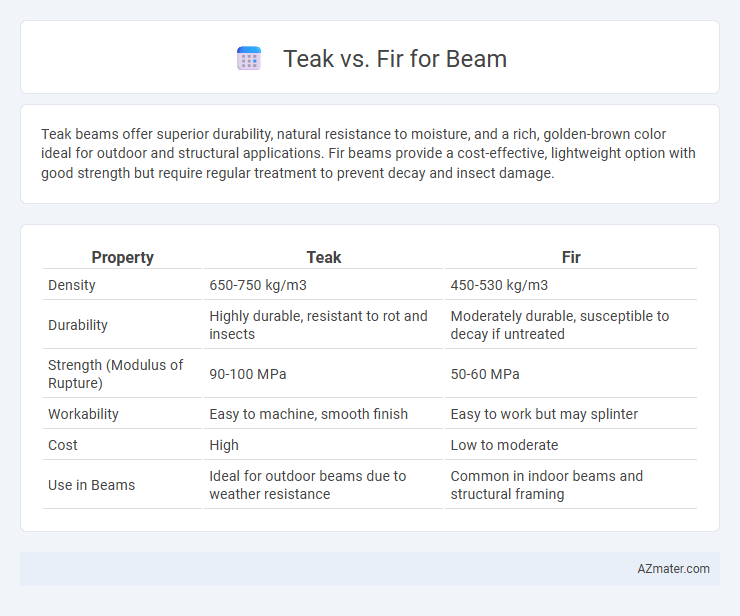Teak beams offer superior durability, natural resistance to moisture, and a rich, golden-brown color ideal for outdoor and structural applications. Fir beams provide a cost-effective, lightweight option with good strength but require regular treatment to prevent decay and insect damage.
Table of Comparison
| Property | Teak | Fir |
|---|---|---|
| Density | 650-750 kg/m3 | 450-530 kg/m3 |
| Durability | Highly durable, resistant to rot and insects | Moderately durable, susceptible to decay if untreated |
| Strength (Modulus of Rupture) | 90-100 MPa | 50-60 MPa |
| Workability | Easy to machine, smooth finish | Easy to work but may splinter |
| Cost | High | Low to moderate |
| Use in Beams | Ideal for outdoor beams due to weather resistance | Common in indoor beams and structural framing |
Introduction to Teak and Fir Beams
Teak beams, known for their exceptional durability and natural resistance to moisture and pests, are ideal for structural applications requiring long-lasting support in both indoor and outdoor environments. Fir beams offer a cost-effective alternative with high strength-to-weight ratio, making them suitable for frameworks where lightweight yet sturdy materials are essential. The choice between teak and fir beams depends on balancing factors such as budget, environmental exposure, and desired longevity in construction projects.
Comparative Overview: Teak vs Fir
Teak beams offer superior durability, natural resistance to moisture, and a rich golden-brown color, making them ideal for outdoor or structural applications requiring longevity. Fir beams are more affordable and easier to work with, featuring a lighter color and moderate strength suitable for indoor framing and general construction. While teak provides exceptional stability and resistance to decay, fir's faster growth rate and availability make it a cost-effective choice for large-scale projects.
Durability and Lifespan
Teak offers superior durability and lifespan compared to fir due to its natural oils that resist decay, insects, and moisture, making it ideal for structural beams exposed to harsh conditions. Fir, while strong and lightweight, is more susceptible to rot and insect damage, reducing its effective lifespan unless treated with preservatives. Teak beams can last 50+ years with minimal maintenance, whereas untreated fir typically endures 20-30 years in similar environments.
Strength and Structural Performance
Teak offers superior strength and durability compared to fir, making it ideal for load-bearing beams in construction where structural integrity is critical. Fir is lighter and less dense, resulting in lower compressive and bending strength, which can limit its performance in heavy-duty applications. The high natural oil content and tight grain structure of teak provide enhanced resistance to warping and environmental stress, ensuring long-lasting beam stability.
Resistance to Weather and Termites
Teak beams exhibit superior resistance to weather and termites due to their dense natural oils and tight grain structure, making them ideal for outdoor and high-moisture environments. Fir beams, while more affordable and lighter, lack the same level of natural protection and are more susceptible to decay and termite damage without chemical treatment. Opting for teak significantly enhances durability and reduces long-term maintenance in exposed structural applications.
Workability and Ease of Installation
Teak offers superior workability due to its natural oils, which provide smooth cutting and shaping but may require specialized tools to manage its hardness effectively. Fir is easier to install, as its softer texture allows for quicker nailing and drilling without pre-drilling, making it a preferred choice for fast construction projects. Both woods provide strong structural support, but fir's lighter weight and higher machinability enhance overall installation efficiency compared to teak beams.
Aesthetic Differences: Color and Grain
Teak beams showcase a rich golden-brown hue with a smooth, straight grain that darkens gracefully over time, offering a luxurious and warm aesthetic ideal for high-end interiors. Fir beams display a pale yellow to light reddish-brown color with a pronounced, straight grain that features natural knots, providing a rustic and natural look perfect for traditional or farmhouse styles. The distinct color saturation and grain patterns of teak versus fir influence the overall ambiance, making teak suited for elegant settings and fir favored for more casual, cozy environments.
Cost and Availability
Teak beams are significantly more expensive due to their durability and resistance to pests, making them ideal for long-term construction but harder to source in large quantities. Fir beams offer a more affordable option with wider availability, often preferred for budget-conscious projects despite being less resistant to decay and insect damage. Cost efficiency and local availability typically drive the choice between teak and fir for structural beams in residential and commercial buildings.
Sustainability and Environmental Impact
Teak beams offer exceptional durability and natural resistance to pests, which reduces the need for chemical treatments and extends their lifespan, promoting sustainability. Fir beams, sourced from fast-growing coniferous trees, have a smaller carbon footprint due to quicker regeneration, making them an environmentally friendly choice. Both woods contribute positively to sustainable construction when harvested from responsibly managed forests with certifications like FSC.
Best Applications for Teak and Fir Beams
Teak beams excel in outdoor and marine applications due to their natural oil content, which provides superior resistance to water, pests, and decay, making them ideal for decking, pergolas, and boat construction. Fir beams are preferred for indoor structural support and framing because of their high strength-to-weight ratio, straight grain, and cost-effectiveness, making them suitable for walls, roof trusses, and flooring substructures. Choosing teak ensures durability in harsh environments, while fir offers reliable performance and easier handling in controlled, indoor settings.

Infographic: Teak vs Fir for Beam
 azmater.com
azmater.com